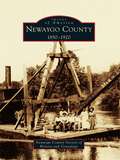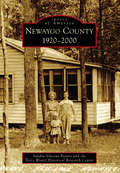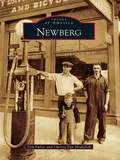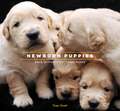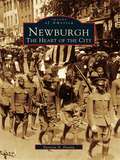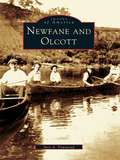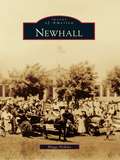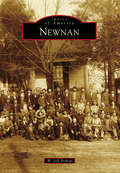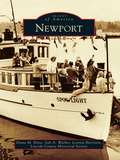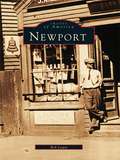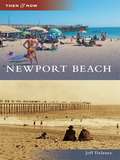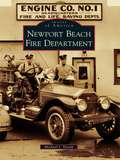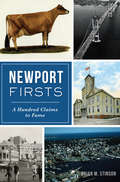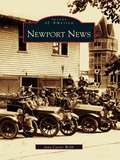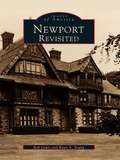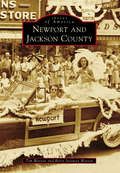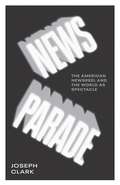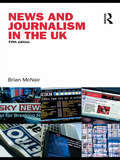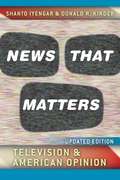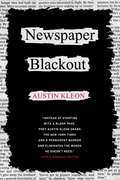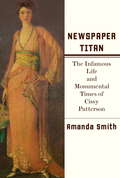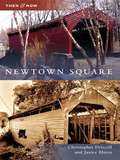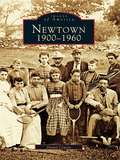- Table View
- List View
Newaygo County: 1850-1920
by Newaygo County Society of History and GenealogyPioneers in Newaygo County were motivated by the call of adventure and a chance to make a fortune in the vast wilderness. The first settlers came to lumber the virgin white pine that grew in the Newaygo forests. The Muskegon River flowed through the region and, along with the White River and many creeks and lakes, offered a major waterway to float logs to Lake Michigan. As early as 1837, Newaygo loggers were floating logs to market, becoming large contributors to the lumbering industry. Lumber from Newaygo County was used to rebuild Chicago after the Great Fire of 1871. In 1851, legislature gave Newaygo independence to form a county and Newaygo County entered a growth spurt that continues to this day. With the coming of the railroad in 1872 and a rapid increase in population, small settlements started popping up. As areas became logged out, many of these settlements died and have been long forgotten; many others remained and thrive today. Newaygo County: 1850-1920 preserves the history of these settlements and the people who built them.
Newaygo County: 1920-2000 (Images of America)
by Sandra Vincent Peavey Terry Wantz Historical Research CenterPeople moved into Newaygo County to farm, as the terrain offered beneficial conditions for planting crops and orchards, and eventually the area developed into several interwoven farming communities. Once agriculture took root, others businesses and crafts found a marketplace within county limits, and Newaygo began to grow while still maintaining a sense of hometown warmness and caring. Residents are proud of their heritage and history and know how to enjoy the surrounding natural beauty regardless of the season.
Newberg
by Christy Van Heukelem Tom FullerThe land that became the city of Newberg played a crucial role in the founding of the state of Oregon. It provided the second permanent encampment after Fort Astoria for trappers coming to the Pacific Northwest. Ewing Young came to Oregon in 1834, claiming as his own a vast stretch of land around his home in the Chehalem Valley. When Ewing died without a will, nearby residents gathered to settle Ewing's estate. This event led directly to the vote at Champoeg to make Oregon part of the United States. The town's name was given by pioneer Sebastian Brutscher after his Bavarian hometown of Neuburg. Other settlers arrived, and soon Newberg was a thriving pioneer town. Among the new settlers were members of the Friends Church, who set up an academy that is today one of the premier Christian universities in the country. Newberg was also home or way station to two U.S. presidents.
Newborn & Maternity Photography: Learn the Skills and Build a Business
by Kristina MackHave you always dreamt of turning your photography hobby into a business, but don't feel you have the skills or accumen to succeed? Newborn and maternity photography is one of the fastest-growing businesses for photographers to move into, and with a seasoned pro as your guide you can quickly learn the secrets of success. In this book, acclaimed newborn and maternity photographer Kristina Mack shares her knowledge of the creative and practical aspects of the genre, and also the tricky business of making a living from capturing this unique stage of the human experience.
Newborn & Maternity Photography: Learn the Skills and Build a Business
by Kristina MackHave you always dreamt of turning your photography hobby into a business, but don't feel you have the skills or accumen to succeed? Newborn and maternity photography is one of the fastest-growing businesses for photographers to move into, and with a seasoned pro as your guide you can quickly learn the secrets of success. In this book, acclaimed newborn and maternity photographer Kristina Mack shares her knowledge of the creative and practical aspects of the genre, and also the tricky business of making a living from capturing this unique stage of the human experience.
Newborn Puppies
by Traer ScottDog lovers who haven't raised puppies from birth have missed out on one of the most remarkable and adorable times in a dog's life. From one to twenty-one days old, puppies undergo great changes, from needing their mothers' complete care to opening their eyes and ears to the outside world, growing, stretching their legs, and learning to become the dogs that they are. Author/photographer (and new mother) Traer Scott's love of dogs shines through these intimate images of a range of breeds and types, from champion pups to shelter strays, all of them irresistible. Including an introduction on puppies' development and the importance of their welfare, this delightful book reveals young dogs as they embark on the adventures of growing up.
Newburgh: The Heart of the City
by Patricia A. FavataNewburgh: The Heart of the City focuses on one of the widest thoroughfares in the Northeast, Broadway, the main street in Newburgh, measuring one hundred thirty-two feet across. Known as "the heart of the city," Broadway was the activity center in the twentieth century. It was lined with government offices, commercial and business enterprises, schools, churches, restaurants, firehouses, farms, fortune-tellers, and entertainment and recreational establishments. Broadway was not only the street of everyman but also the street of presidents, playing host to both Franklin D. Roosevelt and John F. Kennedy.
Newfane and Olcott
by Avis A. TownsendNewfane and Olcott are adjoining communities in western New York where residents relish the past and look toward a prosperous future. Some say they can hear the music of the big bands playing along the shoreline of Lake Ontario from the foundation of the long-demolished Olcott Beach Hotel. Others swear they can see the ghost of Malinda standing by the upstairs window of the beautiful Van Horn Mansion, guarding the grounds where her body was lost for one hundred fifty years.
Newhall
by Maggi PerkinsNewhall's many firsts include the first gold discovery in California and the first commercially successful oil well, which led to the first pipeline and oil refinery in California. Some of the earliest movie location filming was done here. First recorded by Juan Crespi on the Sacred Expedition of 1769, the Little Santa Clara Valley was recognized by the Spanish as an important junction between the mountain ranges separating Northern and Southern California. The early city fathers of Los Angeles saw the settlement of Newhall as an integral part of their strategy for growth from the days of the stagecoach and railroad through to the building of Ridge Route and Interstate 5. This book tells the story of the town that never quite lived up to its potential but still managed a varied history with a colorful cast rivaling those of the movies filmed here.
Newnan (Images of America)
by W. Jeff BishopNewnan, founded in 1828 in the rolling Piedmont section of west Georgia, has long been known as the "City of Homes." While many small towns in the South have been burned, bulldozed, or transformed by industry and development, Newnan retains much of its 19th-century charm and elegance, including more than a dozen restored antebellum homes and a 1904 courthouse on the downtown square. The town produced two of Georgia's most progressive governors and provided writer Erskine Caldwell with his earliest, formative memories. Newnan is the small town that country music singer (and native son) Alan Jackson immortalized in his hit song "Little Man"; in these pages, readers will see the "old Lee King's apothecary" and other downtown buildings that Jackson found so inspiring during his childhood.
Newport
by Lincoln County Historical Society Jodi Weeber Diane Disse Loretta HarrisonNewport and its surrounding areas are beautiful and bountiful, offering resources for fishing, logging, shipping, and tourism. Today's community, similar to populations that settled the land in earlier days, is independent, hearty, and versatile. The Yacona, the Native Americans who called Newport home before the arrival of other cultures, lived almost entirely off the land and waterways. Later settlers, while still reliant on natural resources, integrated technology into the growth of their society. As the area matured, the desire to find balance and preserve natural resources grew. Today Newport's heritage remains strong, and this book serves as a tribute to its history.
Newport (Images of America)
by Rob LewisFounded in 1639, the city of Newport offered a temperate climate and a wealth of natural resources to early settlers seeking religious freedom. In Colonial times, Newport flourished as one of New England's largest seaports, a prosperity dimmed only by the Revolutionary War and subsequent three-year British occupation. Despite the fact that more than one-third of existing homes in Newport were destroyed by the British during their stay, Newport today still has the largest number of eighteenth-century homes of all cities in the United States. In 1968, the Newport RestorationFoundation was founded by tobacco heiress Doris Duke to preserve, protect, and restore the city's eighteenth and nineteenth-century architecture. The foundation's extensive photographic archives have been made available to area resident and modern-day photographer Rob Lewis in the creation of this new and exciting photographic history.
Newport Beach
by Jeff DelaneyNewport Beach, with its picturesque harbor and 10 miles of sandy beaches, has seen great change since its beginnings in the post-Civil War era. Originally a shipping port, it evolved into a haven for movie stars, rumrunners, and gamblers and finally transformed into today's exclusive beach community and popular vacation destination. In his third book on Newport Beach, author and longtime resident Jeff Delaney opens a door between Newport's past and what remains.
Newport Beach Fire Department (Images of America)
by Michael J. NovakFor nearly a century, the men and women of the Newport Beach Fire Department have served their Orange County community with dedication, professionalism, and grace. Starting with a primitive hose reel and a dozen volunteers in 1911, determined Newport Beach firefighters protected the always tourism-friendly community with more dedication than equipment. In 1927, the volunteers were disbanded and a paid fire department was organized. This volume celebrates 100 years of the Newport Beach Fire Department's exemplary service by combining historical photographs with a narrative that traces the evolution of firefighting in Newport Beach from its turn-of-the-century roots to the state-of-the-art operation it is today, entrusted with protecting one of coastal California's most affluent and picturesque showcase communities.
Newport Firsts: A Hundred Claims to Fame (RI)
by Brian M. StinsonNewport, Rhode Island, has been a city of innovation since its beginning nearly four centuries ago. Some of the claims on a national level are true, while some have been greatly distorted over the years. The freethinking citizens include the first to defeat a British squadron and the author of the first written constitution guaranteeing the right to religious freedom in world history. The first law banning the importation of slaves in the colonies was enacted in the city, and the first Methodist church in the world with a steeple and bell is located here. But was the first female lighthouse keeper in America from here? Was Newport the first place where a medical lecture was given? Author and research historian Brian M. Stinson offers a chronological collection of vignettes detailing the city's many firsts.
Newport News
by Jane Carter WebbWithin slightly more than 100 years, the sleepy village of Newport News has transformed itself from a sparsely populated region of watermen and farmers to a city known as one of the nation's greatest centers for shipbuilding, scientific research, Virginia history, and scenic sites. Nestled along the eastern coast of Virginia on the James River, Newport News has a colorful and dynamic history intrinsically linked to the surrounding water. As the town filled with people of great energy and enthusiasm, their hard work propelled local industry to the forefront of the city's reputation.
Newport Revisited
by Rob Lewis Ryan A. YoungIn the three-hundred-fifty-plus years that Newport has existed, it has held a fascination for those who love the sea. Along its narrow streets are nestled the largest collection of preserved eighteenth-century and nineteenth-century dwellings in America. The sailing is spectacular, and the natural harbor is a safe haven for boats. Newport Revisited uses vintage photographs to explore Newport from the 1880s to the 1960s. The book takes the reader on a historic tour to see what people from all parts of the world travel to get a taste of, such as the amazing mansions and the natural beauty of this unique town. Newport Revisited shows the reader the Colony House, Brick Market, and many other exciting sites.
Newport and Jackson County (Images of America)
by Tim Watson Betsy Jacoway WatsonFor almost 200 years, Jackson County has been a typical farming community in the Mississippi Delta. Based on timber, cotton, and freshwater pearls, its early economy produced great wealth for a small group of landowners. In the 1920s, Jackson County was the 10th-largest cotton producer in the country. However, with the arrival of the tractor in the 1950s and the departure of the laboring classes, the county's economy spiraled downward. The tensions in this social mix led to a creative fermentation that allowed Jackson County to become one of the birthplaces of rock and roll. Images of America: Newport and Jackson County tells many of the colorful stories of the history of the county, from land barons and sharecroppers to Elvis, illuminating the rich heritage of its apparently simple towns and communities.
News Parade: The American Newsreel and the World as Spectacle
by Joseph ClarkA fascinating look at the United States&’ conflicted relationship with news and the media, through the lens of the newsreel When weekly newsreels launched in the early twentieth century, they offered the U.S. public the first weekly record of events that symbolized &“indisputable evidence&” of the news. In News Parade, Joseph Clark examines the history of the newsreel and how it changed the way Americans saw the world. He combines an examination of the newsreel&’s methods of production, distribution, and reception with an analysis of its representational strategies to understand the newsreel&’s place in the history of twentieth-century American culture and film history.Clark focuses on the sound newsreel of the 1930s and 1940s, arguing that it represents a crucial moment in the development of a spectacular society where media representations of reality became more fully integrated into commodity culture. Using several case studies, including the newsreel&’s coverage of Charles Lindbergh&’s transatlantic flight and the Sino–Japanese War, News Parade shows how news film transformed the relationship between its audience and current events, as well as the social and political consequences of these changes. It pays particular attention to how discourses of race and gender worked together with the rhetoric of speed, mobility, and authority to establish the power and privilege of newsreel spectatorship.In the age of fake news and the profound changes to journalism brought on by the internet, News Parade demonstrates how new technologies and media reshaped the American public&’s relationship with the news in the 1930s—a history that can help us to better understand the transformations happening today.
News and Journalism in the UK
by Brian McNairNews and Journalism in the UK is an accessible and comprehensive introduction to the political, economic and regulatory environments of press and broadcast journalism in Britain and Northern Ireland. Surveying the industry in a period of radical economic and technological change, Brian McNair examines the main trends in journalistic media in the last two decades and assesses the challenges and future of the industry in the new millennium. Integrating both academic and journalistic perspectives on journalism, topics addressed in this revised and updated edition include: the rise of online journalism and the impact of blogging on mainstream journalism the emergence of 24 hour news channels in the UK the role and impact of journalism, with reference to issues such as democracy, health scares and the war on terror trends in media ownership and editorial allegiances 'Tabloidisation', Americanisation and the supposed 'dumbing down' of journalistic standards the implications of devolution for regional journalists.
News that Matters: Television and American Opinion, Updated Edition
by Shanto Iyengar Donald R. KinderAlmost twenty-five years ago, Shanto Iyengar and Donald R. Kinder first documented a series of sophisticated and innovative experiments that unobtrusively altered the order and emphasis of news stories in selected television broadcasts. Their resulting book News That Matters, now hailed as a classic by scholars of political science and public opinion alike, is here updated for the twenty-first century, with a new preface and epilogue by the authors. Backed by careful analysis of public opinion surveys, the authors show how, despite changing American politics, those issues that receive extended coverage in the national news become more important to viewers, while those that are ignored lose credibility. Moreover, those issues that are prominent in the news stream continue to loom more heavily as criteria for evaluating the president and for choosing between political candidates. “News That Matters does matter, because it demonstrates conclusively that television newscasts powerfully affect opinion. . . . All that follows, whether it supports, modifies, or challenges their conclusions, will have to begin here. ”—The Public Interest
Newspaper Blackout
by Austin KleonPoet and cartoonist Austin Kleon has discovered a new way to read between the lines. Armed with a daily newspaper and a permanent marker, he constructs through deconstruction--eliminating the words he doesn't need to create a new art form: Newspaper Blackout poetry. Highly original, Kleon's verse ranges from provocative to lighthearted, and from moving to hysterically funny, and undoubtedly entertaining. The latest creations in a long history of "found art," Newspaper Blackout will challenge you to find new meaning in the familiar and inspiration from the mundane.Newspaper Blackout contains original poems by Austin Kleon, as well as submissions from readers of Kleon's popular online blog and a handy appendix on how to create your own blackout poetry.
Newspaper Titan: The Infamous Life and Monumental Times of Cissy Patterson
by Amanda SmithThe galvanizing story of Eleanor Medill (Cissy) Patterson, celebrated debutante and socialte, scion of the Chicago Tribune empire, and the twentieth century's first woman editor in chief and publisher of a major metropolitan daily newspaper, the Washington Times-Herald. She was called the most powerful woman in America, surpassing Eleanor Roosevelt, Bess Truman, Clare Boothe Luce, and Dorothy Schiff.Cissy Patterson was from old Republican stock. Her grandfather was Joseph Medill, firebrand abolitionist, mayor of Chicago, editor in chief and principal owner of the Chicago Tribune, and one of the founders of the Republican Party who delivered the crucial Ohio delegation to Abraham Lincoln at the convention of 1860.Cissy Patterson's brother, Joe Medill Patterson, started the New York Daily News.Her pedigree notwithstanding, Cissy Patterson came to publishing shortly before her forty-ninth birthday, in 1930, with almost no practical journalistic or editorial experience and a life out of the pages of Edith Wharton (or more likely the other way around: shades of Cissy are everywhere in the Countess Olenska). Amanda Smith writes that in the summer of 1930, Cissy Patterson, educated at the turn of the century at Miss Porter's School in Farmington, Connecticut, for a vocation of marriage and motherhood and a place in society, took over William Randolph Hearst's foundering Washington Herald and began to learn what others believed she could never grasp--how to run and build up a newspaper. She vividly lived out the Medill family's editorial motto (at least in spirit): "When you grandmother gets raped, put it on the front page."Patterson soon bought from Hearst the Herald's evening sister paper, the Washington Times, merged the two, and became editor, publisher, and sole proprietor of a big-city newspaper, a position almost unprecedented in American history. The effect of the merger was "electric"...By 1945, the Washington Times-Herald, with ten daily editions, was clearing an annual profit of more than $1 million.Amanda Smith, in this huge, fascinating biography gives us the (infamous) life and monumental times of Cissy Patterson, scourge of liberals, advocate of appeasing Hitler, lover of poodles, and hater of FDR.Here is her twentieth-century Washington: its politics and society, scandals and feuds, and at the center--the fierce newspaper wars that consumed and drove the country's press titans, as Patterson took the Washington Times-Herald from a chronic tail-ender in circulation and advertising, ranked fifth in the town, and made it into the most widely read round-the-clock daily in the national's capital, deemed by many to be "the damndest newspaper to ever hit the streets."
Newtown Square
by Christopher Driscoll Janice ElstonNewtown Township, more commonly known today as Newtown Square, is the oldest township in Delaware County, Pennsylvania. While Newtown was mostly farmland until the mid-20th century, it has developed significantly since World War II. Over 100 historic homes and buildings remain along Newtown's four-lane highways, country roads, and neighborhoods. Newtown Square provides a glimpse at the township's changes from rolling countryside to continually growing suburb.
Newtown: 1900-1960
by Daniel CrusonNewtown changed most dramatically in the period from 1900 to 1960, and Newtown: 1900-1960 captures these changes photographically to show how Newtown became the suburban town with a small-town atmosphere that it is today. The book includes an outstanding array of photographs from three recently discovered collections, including a series on the army maneuvers of 1912, which shows the state of the American army before World War I. Newtown: 1900-1960 begins with the village, which is truly the heart of the town. It focuses on institutions such as the Newtown Savings Bank, which was the business center for almost a century and a half. The book then examines the industrial section of town, Sandy Hook, with businesses that both sustained life and just made life more pleasant. In addition, the book looks at the outlying settlements of Stevenson, Hattertown, Hawleyville, and Riverside, a summer colony that became a year-round place.
